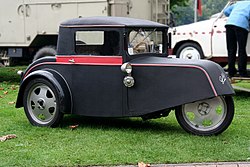Goliath pioneer
| Goliath | |
|---|---|
|
Goliath pioneer
|
|
| pioneer | |
| Production period: | 1931-1934 |
| Class : | Microcar |
| Body versions : | Coupé , convertible |
| Engines: |
Otto engines : 0.2–0.25 liters (4–5 kW) |
| Length: | 3100 mm |
| Width: | 1500 mm |
| Height: | 1400 mm |
| Wheelbase : | 1900 mm |
| Empty weight : | 350 kg |
| successor | Hansa 400 |
The Goliath Pioneer was a small car from the Hansa-Lloyd and Goliath works in Borgward & Tecklenborg in Bremen-Hastedt .
history
For the Berlin Motor Show 1931, Carl F. W. Borg Ward before his first car. Series production began in the same year, according to other sources not until the beginning of 1932. The poor economic situation in Germany, which was caused by the global economic crisis , meant that even middle classes of the population could only buy inexpensive miniature cars, if at all.
The last model year was 1934. Shortly before the end of production, the pioneer received a new body with a hatchback . A total of 4,000 vehicles were sold in three years, only a few hundred with hatchbacks. Due to the improvement in the general economic situation in Germany during the Third Reich , the very simple car with a selling price of almost 1,500 Reichsmarks was no longer interesting even for less well-heeled buyers and its production was discontinued.
Engine, transmission and chassis
Right from the start, the pioneer was optionally available with two different engines. Both were single-cylinder two-stroke engines , came from ILO , and were installed in the rear of the three-wheeled vehicles. The weaker one had an output of 5.5 hp (4 kW) at 3200 rpm. With a bore of 61 mm and a stroke of 68 mm, the displacement was 198 cm³. The compression ratio was given as 5.2: 1. A single Zenith carburetor prepared the mixture.
The more powerful engine was a drilled out version of the weaker one from the same manufacturer, had a displacement of 247 cm³ (bore × stroke = 68 mm × 68 mm) and developed 6.7 HP (5 kW) at 3200 rpm. Compression and carburetor corresponded to those of the weaker model.
The maximum speed of the Goliath Pioneer was 50 km / h, according to other sources at 60 km / h.
All cars had an unsynchronized three-speed gearbox with a middle shift (stick shift). The rear wheels were driven.
The superstructures were mounted on a U-shaped pressed steel frame support. The single front wheel hung on a rocker arm with a cantilever spring (leaf spring), the rear pendulum swing axle on two transverse leaf springs. The service brake worked mechanically on the rear wheels; the handbrake also mechanically on the individual front wheel.
The fuel consumption (gasoline mixed with oil) of the Goliath Pionier was 5 liters / 100 km. An 8 liter tank was installed in the front of the car.
Bodies
Both types were available as two-door two-seat coupes and convertibles ; the doors were hung at the front. The bodies consisted of an ash wood frame that was covered with synthetic leather ( Weymann body ). The windshield was upright and the headlights were on the A-pillars . In the first two years of production, the rear window was also vertical. It wasn't until 1934 that there was a body with a hatchback .
The three-wheeled vehicles with a 198 cm³ engine and an empty weight of just under 350 kg could be driven without a driver's license and were exempt from vehicle tax.
Individual evidence
- ↑ a b c d e f g h i j k l m Werner Oswald : Deutsche Autos 1920–1945 . Motorbuch Verlag, Stuttgart 1996. 10th edition. ISBN 3-87943-519-7 . P. 151.
- ↑ a b c d Werner Oswald: German Cars 1920–1945 . Motorbuch Verlag, Stuttgart 1996. 10th edition. ISBN 3-87943-519-7 . P. 150.
- ^ A b c Georg Schmidt: Borgward - Carl FW Borgward and his cars . Motorbuch Verlag, Stuttgart 1982. 3rd edition. ISBN 3-87943-679-7 . P.56.
- ↑ a b German Museum. Goliath pioneer . Retrieved May 18, 2017.
- ^ Georg Schmidt: Borgward - Carl FW Borgward and his cars . Motorbuch Verlag, Stuttgart 1982. 3rd edition. ISBN 3-87943-679-7 . P. 224.

